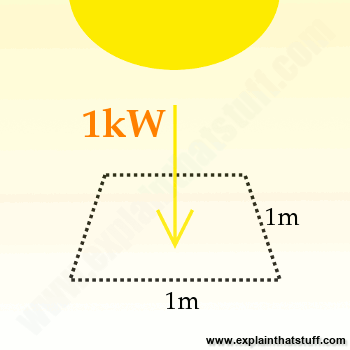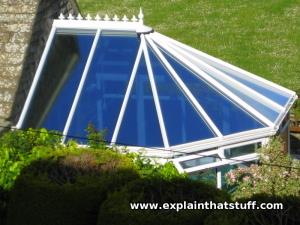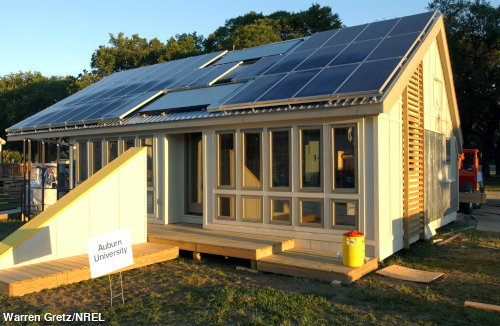
Passive solar buildings
by Chris Woodford. Last updated: June 9, 2023.
It's a cold December day in England and the temperature outside is maybe 4°C (39°F). Even so, I'm sitting by the window in the Sun feeling really quite warm (and I have clothes drying outside in the sunlight that I expect will be 50–75 percent done when I bring them indoors later on). What I'm making use of here is passive solar energy: my body is capturing the hidden heat in sunlight, storing it in its mass, and allowing it to distribute itself to other parts of my body that are not directly in the heat of the Sun. Architects design buildings the same way to capture, store, and distribute solar energy so they have lower heating and air-conditioning costs and reduced environmental impact. How do passive solar buildings work? Let's take a closer look!
Photo: This eco-friendly home in Idaho Springs, Colorado is designed around passive solar technology, including large areas of sun-facing glass and a Trombe wall (explained below) to trap sunlight. Overhangs provide shade and prevent overheating in summer. Photo by Warren Gretz courtesy of US DOE/NREL (NREL photo id#26343).
Sponsored links
Contents
What is solar energy?
The easy answer is "energy from the Sun." But sun light is actually a mixture of light and heat, and the light itself is a mixture of different frequencies of electromagnetic radiation, including invisible ultraviolet (the sunlight that gives you sunburn) and infrared (the invisible light you feel as radiated heat if you stand near something like a camp fire or barbecue). The great thing about solar energy is that it's plentiful and free. In theory, every horizontal square meter of Earth receives about 1kW of power from the Sun (assuming overhead Sun at midday and a cloudless sky): that's 1000 joules of energy every single second, which adds up to a huge amount over the course of a (sunny) day. Colder, cloudier countries receive much less energy than this, but even correcting for latitude, seasons, and cloud, dull countries like Britain can still usefully access at least 100 watts per square meter (according to the calculations of physicist David MacKay).

Artwork: At noon on a cloudless day, 1000 watts (1 kilowatt) of solar power hits one square meter (roughly a square yard) of Earth. An even more impressive way to frame this (according to physicist Richard Muller's Physics for Future Presidents, p.78) is that there's potentially a gigawatt of solar power in a square kilometer of land—which the same as you'd get from a typical nuclear plant.
What can we do with solar energy? Broadly, we can capture it with two different approaches known as active and passive solar. Active solar means things like photovoltaic solar cells (which turn sunlight into electricity) and roof-mounted solar hot-water systems (which capture the sun's heat in water and use a heat exchanger system to store it in a tank for baths and showers). Passive solar generally means capturing and trapping the Sun's heat inside a building—and that's what the rest of this article will look at in more detail.

Photo: If you have a conservatory like this, you'll be well aware of passive solar energy. Unless you fit it with blinds or low-e windows.
What is passive solar?
You can buy homes off the shelf—prefabricated boxes that you put together like self-assembly IKEA furniture. Prefabricated buildings are, by definition, identical and they look and work the same, whether you build them in Finland, Germany, Mali, or Japan. But a passive solar home is a completely different concept: key to the design is the idea that the house is geared to a very specific local climate (and a particular location within it). At its very simplest, that would mean lots of large, sun-facing windows (south-facing in the northern hemipshere, in somewhere like the UK or the United States, or north-facing in a southern-hemisphere country such as Australia). "Passive" solar means what it says: unlike solar panels and solar-thermal water heating, it uses no electrical or mechanical devices to move heat or light through the building. Instead, the building is designed to soak up, store, and distribute energy naturally.
Passive solar buildings are meant to be environmentally friendly. There would be no point in designing a building that saved 75 percent of its winter heating costs if that same design led to a 300 percent increase in air conditioning expenses in summer. So an essential aspect of passive solar design is achieving year-round effectiveness. Typically, that means being able to screen intense, overhead sunlight (or otherwise reduce its effects) in the heat of summer.
Basic elements of passive solar building design
It's generally agreed that there are several distinct aspects to passive solar design. Broadly speaking, they boil down to capturing heat from the Sun, storing that heat, transmitting or releasing the heat gradually (especially at night or after the Sun has gone down), and finally (another separate aspect) preventing the building from overheating on really hots days (particularly in summertime). Let's consider these in turn.
1. Capturing heat
There are three basic ways of catching the Sun's heat, known as direct, indirect, and isolated solar gain.
Direct gain essentially means that the Sun's heat streams directly, through one or more large sun-facing windows (sometimes referred to as the aperture), into the parts of the building where the heat is required (the main daytime living areas rather than the bedrooms or kitchen, which you most likely want to be cooler). The greater the area of glass, the higher the gain—that's why passive solar homes are generally characterized by huge windows. The windows typically need to be double-glazed to ensure that the building not only traps heat but retains it when the Sun has gone down.
Indirect gain means that the Sun's energy is captured by a wall or window that doesn't directly lead into the living area. Inside, the energy is trapped and feeds slowly into the living areas (and the rest of the home) by conduction, convection, and radiation (the three modes of heat transfer through solids, liquids, and gases). One of the best known examples of indirect gain is the Trombe wall and consists of a window that admits light onto a really thick, dark-colored wall. The wall heats up very gradually and stores the solar energy that it releases slowly into the house for some hours afterward (generally in the evening and at night). In another design, you might have a wall made of pipes in which water sits, soaking up the solar energy and slowly releasing it to the house; a rooftop pond would work in a similar way. (Water has a very high specific heat capacity, which means each liter of water is capable of storing a very large amount of heat energy. That's why it's used as the heat-transfer fluid in central-heating and solar hot-water systems.)

Photo: Indirect gain: A Trombe wall is like a cross between a window and a wall: it's a wall with a glazed surface that heats up and releases its energy into the building behind. Photo by Paul Torcellini courtesy of US DOE/NREL. (NREL photo id#26485)
Isolated gain means the building has a sun-trap of some kind built onto the side—maybe a conservatory, solarium, greenhouse, or other Sun space. It's built almost entirely of glass, heats up quickly, and stores its energy in its floor or walls, slowly releasing it to the rest of the building.

Photo: Isolated gain: The solarium on the side of this office building captures heat and slowly feeds it to the building it's attached to. Photo by Warren Gretz courtesy of US DOE/NREL. (NREL photo id#56223)
2. Storing heat
The Sun might seem like a spotlight in the sky, but it doesn't shine consistently, from the same inclination or direction, all day and all night; passive solar homes need to be able to store up daytime solar energy and slowly release it in the cooler evenings, nights, and early mornings. How? They need large walls or floors with a high thermal mass, made from dense, solid materials such as brick, stone, concrete, blocks of compressed earth, adobe, straw bales, or lighter materials filled with something like water that can store large amounts of heat per unit of volume. Often (but not always), thermal mass is painted black or colored darkly so that it absorbs the maximum (and reflects the minimum) amount of solar heat energy falling upon it. It's not just walls and floors that provide a building's thermal mass: something like a heavy stone or brick fireplace, stone pillars inside a room, or even very heavy wooden doors could also do the job. Ideally, thermal mass will release the heat captured by a passive solar building for 6–10 hours afterward, until the Sun comes around again. The time between a thermal mass absorbing heat and releasing it is known as its thermal lag.

Chart: Cooling effect: An effective thermal mass delays the peak temperature and reduces both the maximum and minimum temperatures inside a building. The blue line shows the rising and falling outside temperature (assuming it's exactly the same over several days). The orange line shows the effect of a small thermal mass. The red line shows how more thermal mass has a bigger effect.
Since thermal mass is designed to release heat over a long period, it's important that it's insulated against heat losses so it doesn't lose energy too quickly, especially in cold climates. That could mean insulating the mass itself (maybe lining the underside of a stone floor), but it also means insulating the building as a whole with, for example, double or triple glazing, air locks, roof insulation, or more sophisticated systems such as heat-recovery ventilation (which lets fresh air into a building without allowing too much heat to escape) or low-e windows (also referred to as low-emissivity or heat-reflecting glass).

Photo: Thermal mass provides temporary heat storage in a passive solar building, but it doesn't have to be as lumpen and unattractive as it sounds. Here's an attractive example of walls and flooring with high thermal mass from the Visitor Center at Zion National Park. You'd never know that one of its primary functions is to store solar heat. Photo by Robb Williamson courtesy of US DOE/NREL. (NREL photo id#26697)
3. Moving heat
In a centrally heated home, water from a furnace or boiler (usually powered by natural gas, electricity, oil, or some other fuel) is pumped around a continuous circuit of pipe, through radiators, to keep the entire building warm. Ideally, passive solar buildings don't use things like boilers and pumps to move heat, or even air ducts and blowers; instead, the heat captured by glazing and stored by thermal mass has to move around the building by the natural processes of conduction (heat flow between solid materials that are touching one another), convection (heat flow through the movement of air), and radiation (where hot objects give off heat by emitting infrared radiation).
4. Winter-summer balance
Keeping a passive solar building cool in summer is just as important as keeping it warm in winter. That's why passive solar buildings feature such things as eaves/overhangs (carefully designed to prevent too much hot, high-level, summer Sun entering a building without cutting off the all-important low-level winter Sun), as well as temporary, adjustable devices such as blinds, awnings, or shutters. Adjustable ventilation obviously also plays an important part, though devices like air vents, exhaust fans, and opening windows can drastically compromise the effectiveness of the building in winter if they increase "air leaks" that allow heat to escape accidentally.

Photo: Overhangs above these windows allow low winter sunlight to penetrate and heat the building, but shade out hotter summer sun. Note how the south side of the building (which receives intense daytime sun) has overhangs, but the north side (which receives little or no direct sun) omits them. Photo by Warren Gretz courtesy of US DOE/NREL. (NREL photo id#16849)
Sponsored links
Planning for passive solar
Apart from catching, storing, and moving heat, the general design of a passive solar building is also hugely important. The architect would need to decide which rooms require most heating in winter and arrange those close together so they soak up most daytime sunlight and pass it on to one another, in turn, by conduction (direct contact) and convection (air movement). A living room would be a prime candidate for direct solar heating, while a kitchen or dining room would more likely want indirect heat from thermal mass in the evenings. Bedrooms and dining rooms need less heating again.
When people talk about passive solar, super-modern, eco-friendly, architect-designed buildings spring to mind. But it's important to remember that passive solar principles can be applied to existing buildings as well. You can add something like a conservatory to your home, add more glazing to capture more solar energy (or use double, triple, or low-e glazing), increase the solar mass or the insulation in the main living areas, or simply use the rooms in your home in a different way (maybe living in the upstairs rooms instead of the downstairs ones, or the front of the house instead of the back, to take advantage of greater winter sunlight). These things are simple examples of maximizing passive solar energy.
Advantages and disadvantages of passive solar buildings
A passive solar building is environmentally friendly and economical and should prove cheap to run all year round. It doesn't have to be hugely expensive; the basic principles are simple and in an ideal passive solar building, there are no noisy, expensive, and even potentially dangerous furnaces or pumps requiring maintenance or refueling. Having large areas of glazing makes a home light and bright, while open-plan interiors (designed to improve air and heat movement) give a feeling of spaciousness. Passive solar works anywhere on Earth (even at the poles, where there is sunlight for at least half the year!) and can be applied to new or existing buildings.
It's hard to think of disadvantages, except where passive solar principles are applied with absolute, idealistic, environmental zeal. Even then, the worst that's likely to happen is that, left to the mercy of the climate, the building could prove too hot in summer or too cold in winter. That's why knowledge of the local climate is particularly important when you design a passive solar building from scratch. There's nothing to stop you having a partly passive solar building with other, more conventional forms of heating and air-conditioning to fall back on if you want to.

Photo: By definition, passive solar homes are light, bright, and sunny, which makes them very attractive living spaces. This is a home designed by Auburn University for a competition called the Solar Decathlon house, in which university and college studies try to build the most attractive and economic eco-friendly homes. Photo by Warren Gretz courtesy of US DOE/NREL. (NREL photo id#105567)
